Driving through the golden peanut fields of Georgia, I dreamed of a quaint, peaceful southern town – the kind of place where a young Jimmy Carter, who would later become president and win a Nobel Prize, began his journey. Welcome to the Jimmy Carter National Historical Park in Plains, Georgia, where the past mixes with the friendly feel of a small-town community. Before adding this stop to your Georgia road trip itinerary, here’s what you should know about uncovering the story of America’s 39th president in the heart of rural, pecan-dotted countryside.
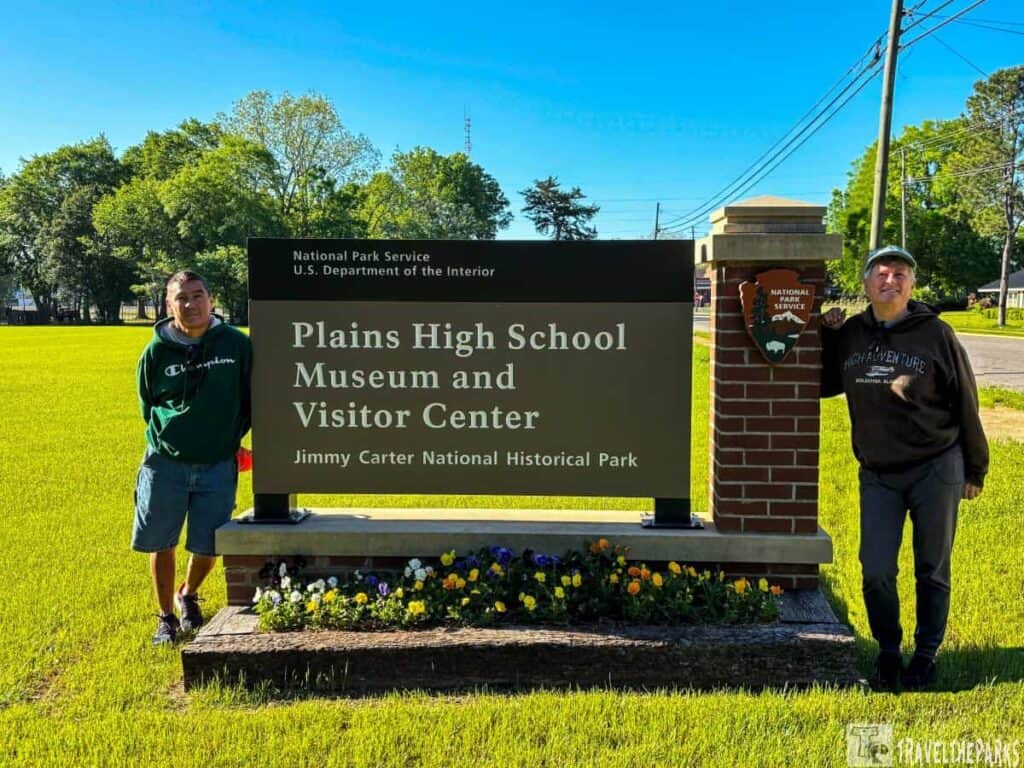
The Jimmy Carter National Historical Park isn’t just a tribute to the former president’s legacy – it’s a celebration of the small-town values and quiet beauty of the American South that shaped him. As you stroll the grounds, you will discover Carter’s humble beginnings and how his hometown roots shaped his remarkable life and career.
This post may contain affiliate links, meaning if you purchase something through one of these links, we may earn a small commission at no extra cost to you! Read the full disclosure policy here.

Table of Contents
Directions to Jimmy Carter National Historical Site
Our journey to the park started from Hard Labor State Park, passing through classic Southern towns like Eatonton, Milledgeville, and Montezuma—each with a bit of historic charm. Getting off the major highways and closer to Andersonville, the roads got quieter, more rural, and surrounded by trees and open fields. Staying at the Andersonville Campground RV park, we did the short drive from Andersonville National Historic Site a mere 20 miles.
To get to the Jimmy Carter National Historical Park in Plains, Georgia, follow these directions based on a starting point of Atlanta, Georgia.
- From Atlanta, Georgia (Approx. 2 hours drive): Get on I-85 S from Downtown Atlanta: Head south on Central Ave SW toward Pine St SE. Take the ramp on the left onto I-85 S. Continue on I-85 S: Take the exit toward US-280 W: Arrive in Plains, Georgia: Follow US-280 W directly into Plains, GA.
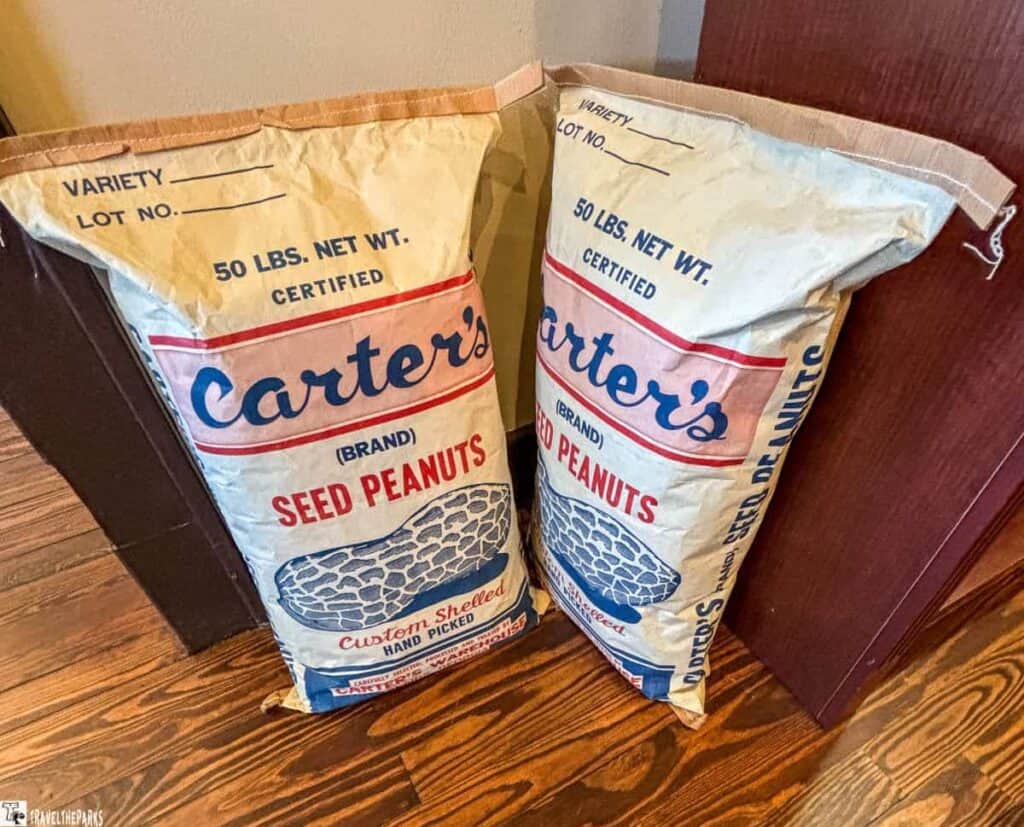
What You Need to Know Before You Go: Jimmy Carter National Historical Park
- Hours of Operation: Jimmy Carter National Historical Park Plains High School Visitor Center is open every day of the week except for major holidays, from 10:00 AM to 5:00 PM. It’s always a good idea to check the park’s website or call ahead for any changes to operating hours, especially around holidays. Depot Hours: Open daily, typically 9:00 AM to 5:00 PM (Check NPS site for updates)
- Admission Fees: The good news? FREE admission! There is no entry fee to visit the Plains High School Museum, the Plains Depot, or the Boyhood Farm.
- Pet Policy: If you’re traveling with your furry friend, you’ll be happy to know that the park is pet-friendly. However, please keep your pets on a leash at all times. Check for specific restrictions before your visit, as some areas, such as inside buildings, prohibit pets.
- Accessibility: The park aims to be accessible to all visitors. Wheelchair access is available to most of the sites, and there are also accessible restrooms. If you have specific needs, don’t hesitate to reach out to the park in advance for any additional accommodations.
- Weather and Best Time to Visit: Georgia weather can be unpredictable, so be sure to check the forecast before you go. Spring and fall are often the best times to visit, with mild temperatures and colorful landscapes. Summer can get hot/humid, but the park offers plenty of shade to keep you cool while you explore.
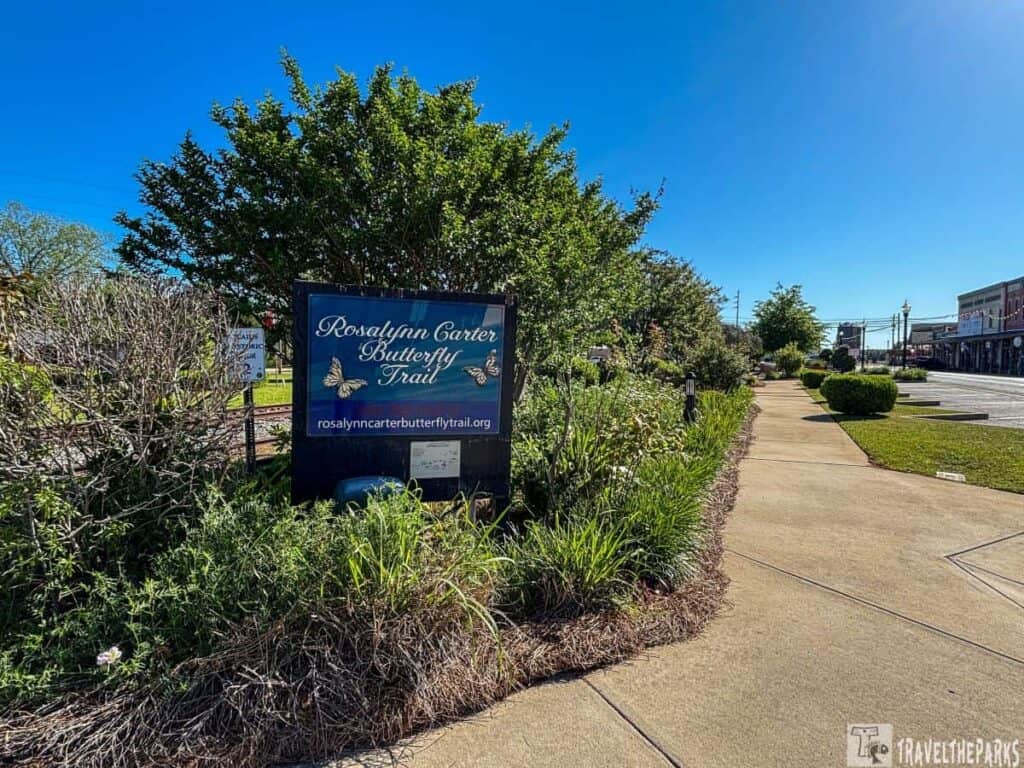
What Things to See and Do at Jimmy Carter National Historical Park
You can see the historic sites at the park in two different ways. The first activity is a walking tour (map) of downtown Plains Georgia. This town is very easy to walk around. We had a great day walking by unique antique stores, the old-fashioned Plains Trading Post and the well-known Buffalo Cafe, which the Carter family loves for its fried chicken and peach pie. Plains is tiny. A few storefronts. The train depot. The family farm down the road. Another way to explore the sites here is by taking a scenic driving tour (Map). Give it 1.5 to 2 hours to enjoy all the stops. We found the driving tour lets you explore Carter’s rural roots and the park’s spread-out sites.
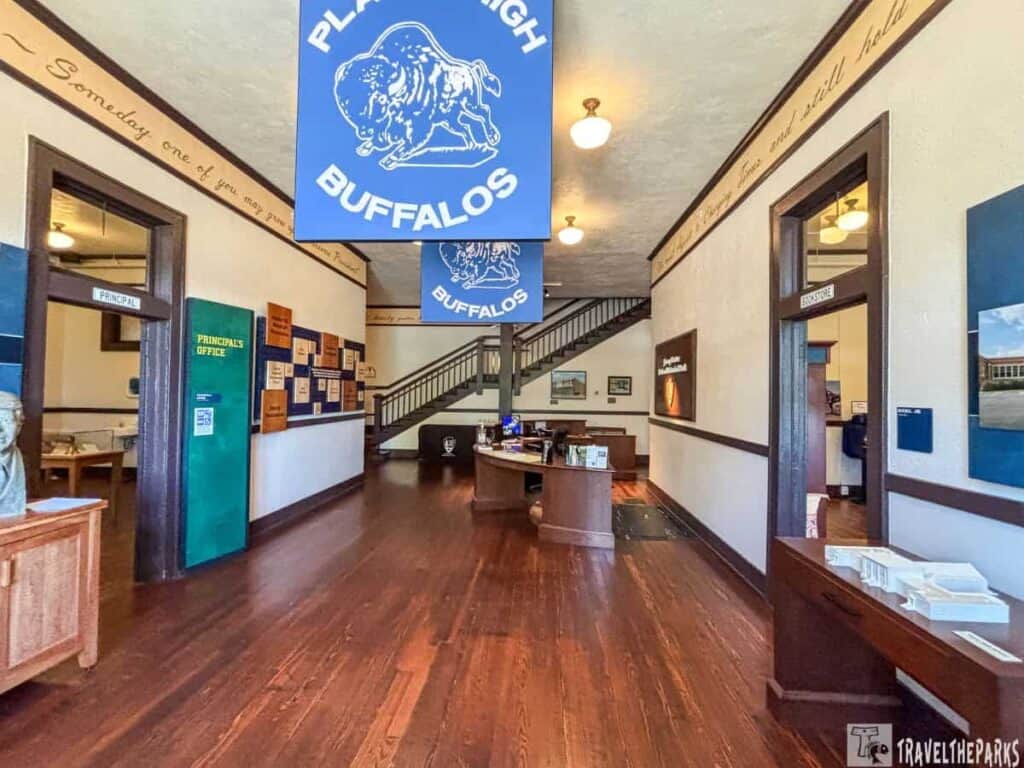
Plains High School Museum: The School That Shaped a President
In the quiet town of Plains, Georgia—population just over 500—there’s a modest brick building that holds more than history. It holds the heart of a man who came from almost nothing and gave the world nearly everything: peace, humility, and unwavering moral clarity. This is Plains High School Museum & Visitor Center, now part of the Jimmy Carter National Historic Site. Stepping through its doors feels like stepping into the moral compass of America’s 39th president.
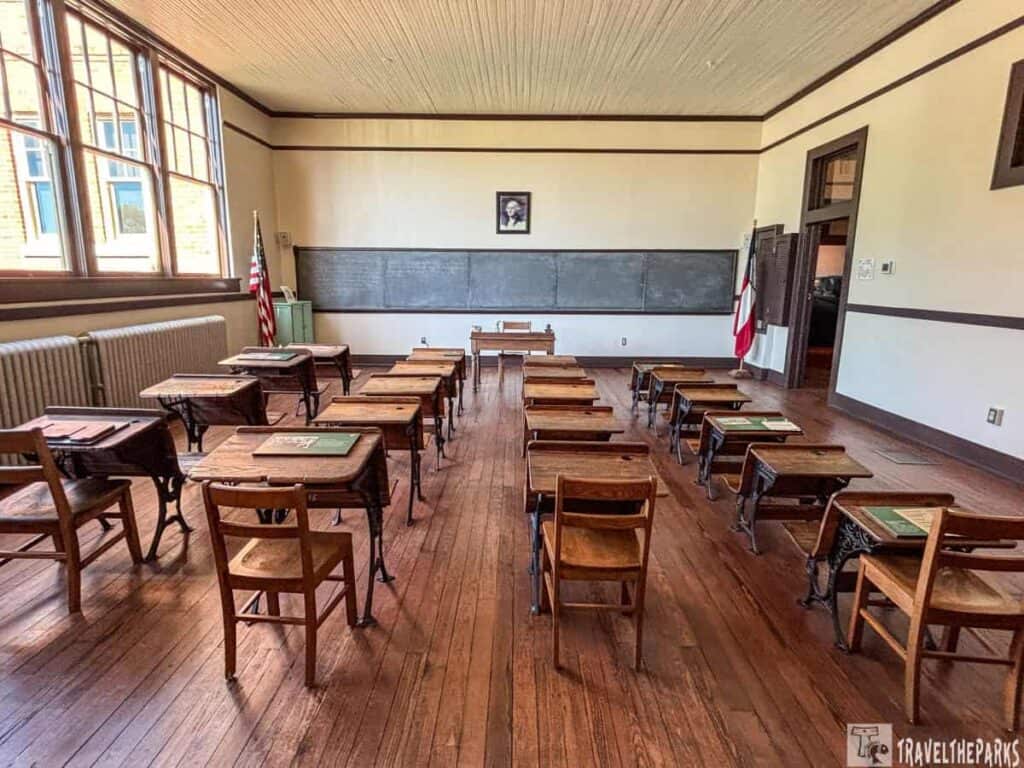
Upon entering, the first thing that struck us was the quiet. The wooden floors creaked softly underfoot. This is where Jimmy and Rosalynn Carter’s educational journey began. It was in this space that Jimmy Carter first grappled with the intricate issues of race, class, service, and justice. Inside, we found classrooms bathed in the warm glow of Georgia sunlight. Here, Carter nurtured the quiet determination that would shape not only his presidency but also his life thereafter.
“We must adjust to changing times and still hold to unchanging principles.”
—Jimmy Carter, Inaugural Address, 1977
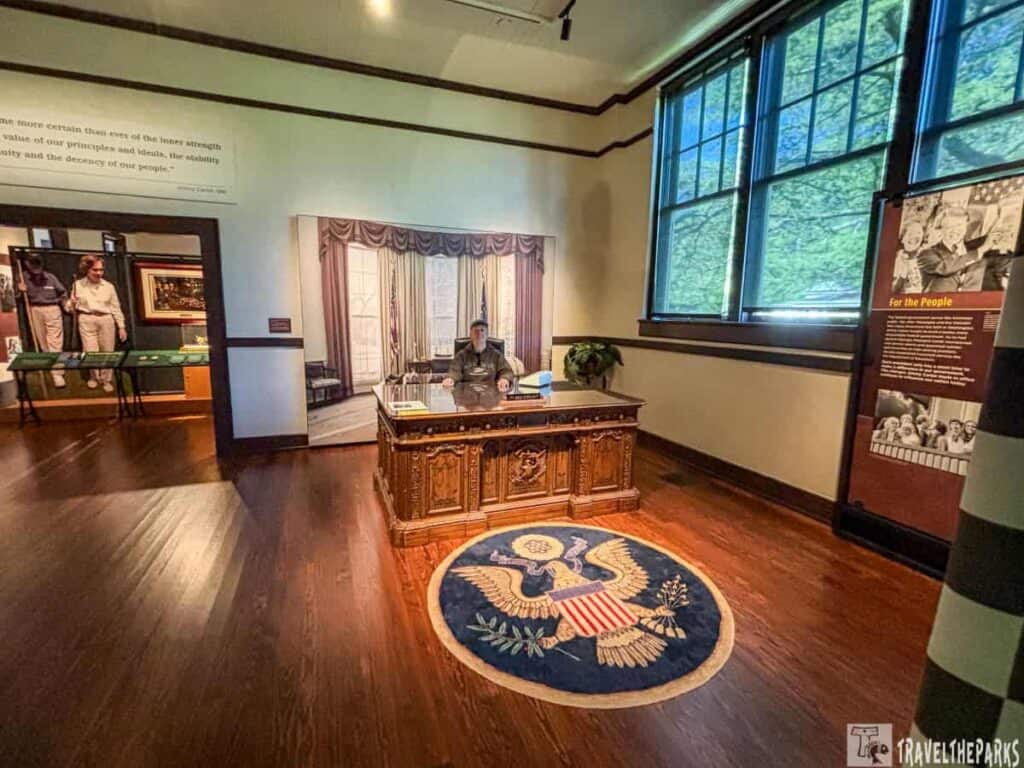
You see those principles in every corner of this museum. Showcased in the display of his Nobel Peace Prize, in the replica of the Oval Office, in the family photographs and handwritten notes. Most strikingly, though, you sense them in the space’s subtlety—it doesn’t aggressively assert Carter’s legacy. As I wandered through the exhibits, I realized this building shaped his values: fairness, honesty, humility, education and faith.
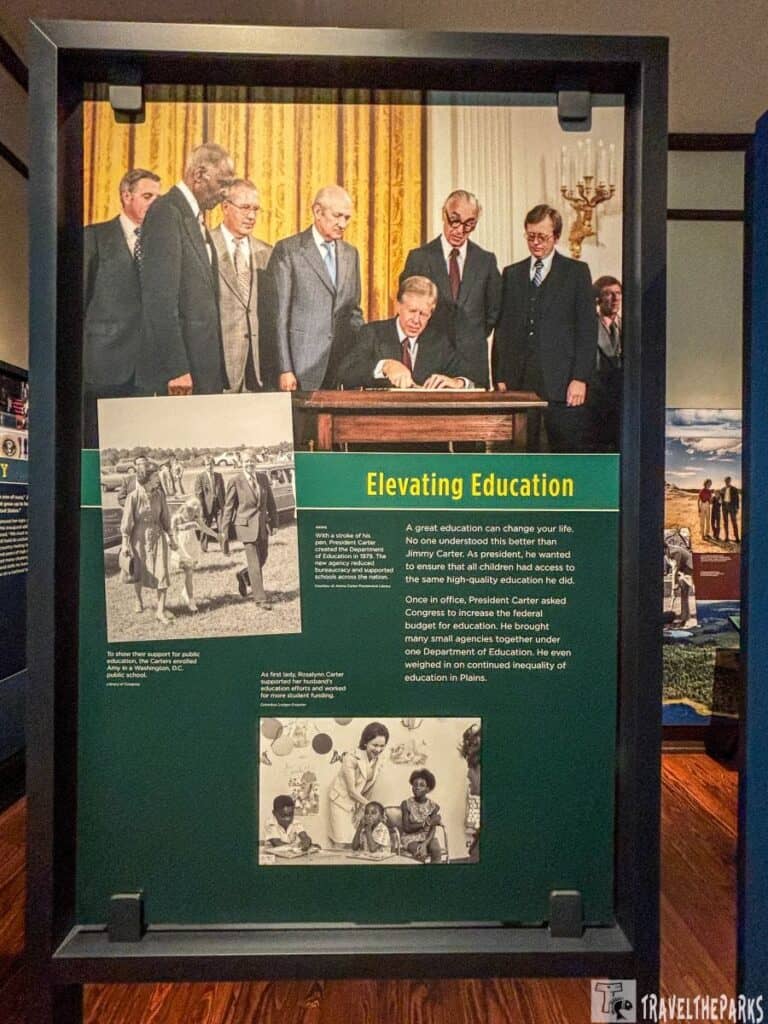
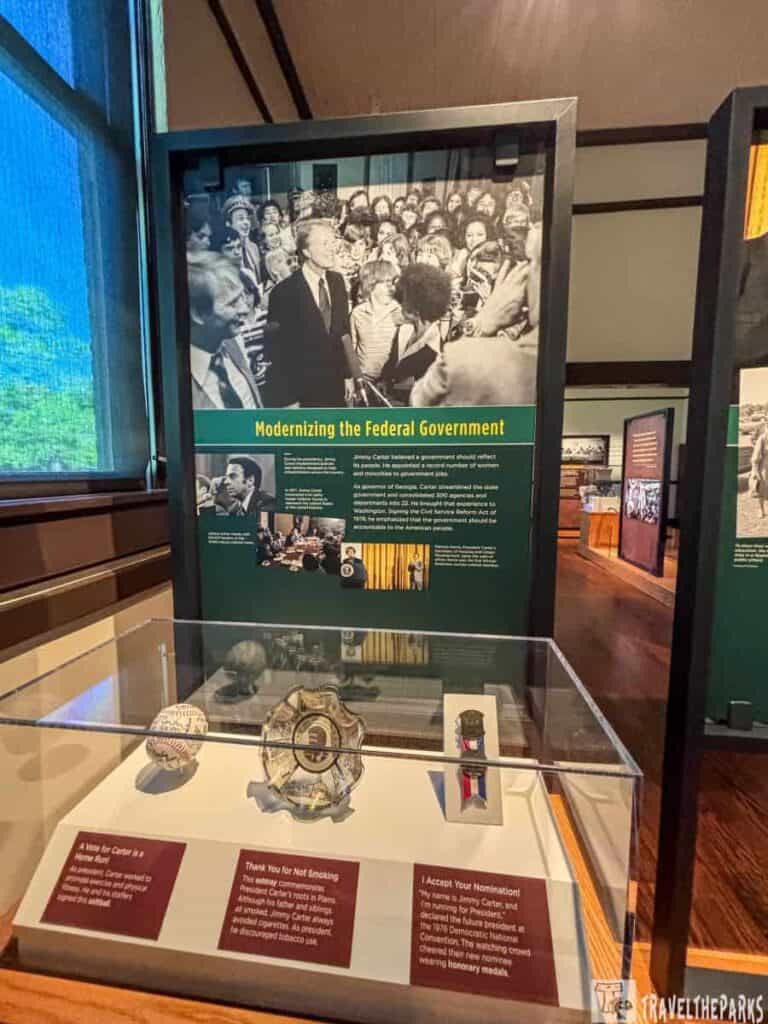
A Walk Through the Halls of History: Jimmy Carter: His Life and Legacy
Visiting Plains High School at the Jimmy Carter National Historic Site isn’t like stepping into just another historic building — it feels like stepping into the soul of a small town that raised a president who never forgot where he came from.
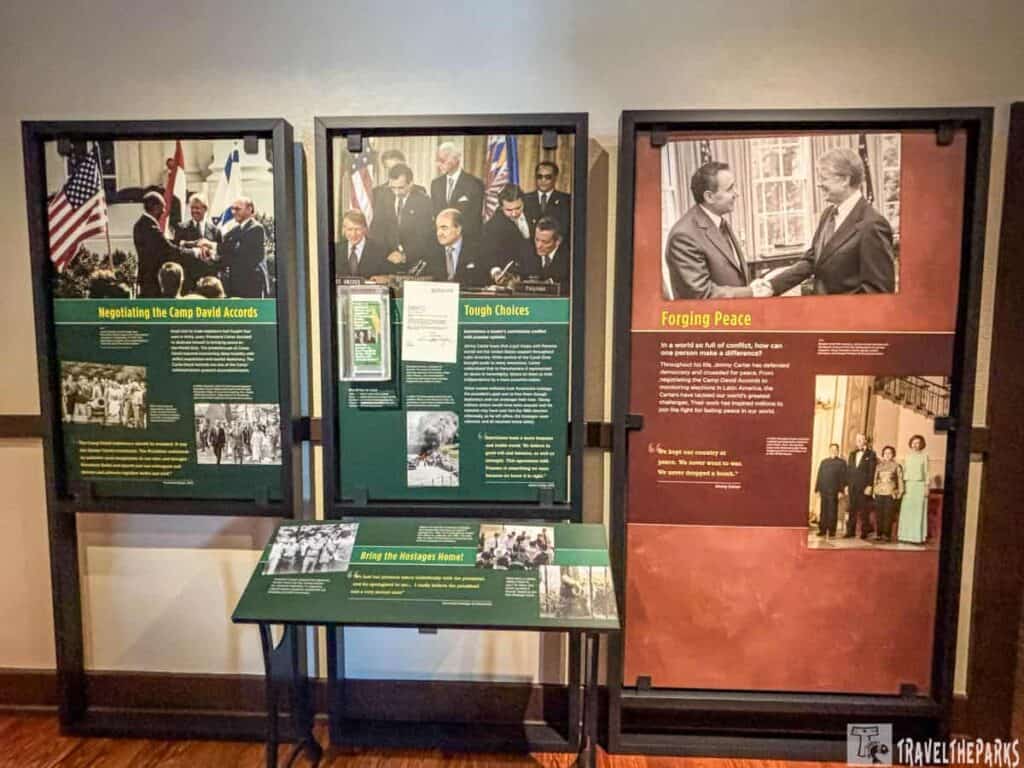
Leaving Plains High school you come to understand integrity is not as an abstract idea, but is a lived experience. Jimmy Carter’s life is a masterclass in consistency: in doing what’s right, even when it’s not popular. He governed with the same moral backbone he lived by, and this little schoolhouse is a time capsule of that ethic.
I thoroughly enjoyed exploring the interactive exhibits and discovering presidential artifacts that shed light on his formative years. Before leaving, we pick up maps and trail guides for the Carter Boyhood Farm and downtown Plains walking tour.
Pro Tip: Visit early to avoid midday crowds, and allow 1–2 hours to explore the museum thoroughly.

The Depot: Campaign Headquarters That Made History
Next, we headed to the Old Plains Train Depot, a small white building that served as Jimmy Carter’s 1976 presidential campaign headquarters. It’s now a National Park Service exhibit, and stepping inside feels like entering a moment frozen in time. There’s something special about standing inside a building where history actually happened—not where it’s reenacted, but where it unfolded in real time, one phone call, one strategy meeting, one typed memo at a time.
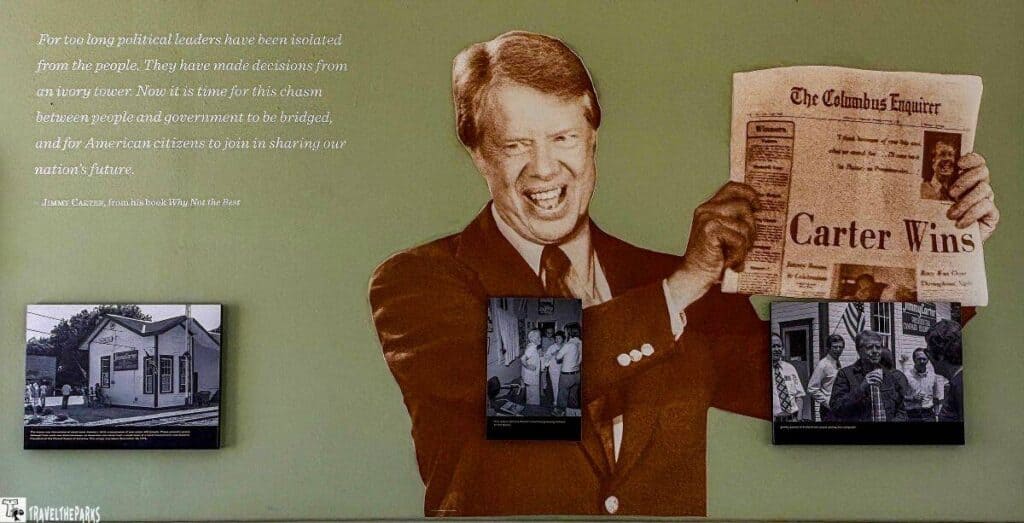
It was fascinating to see original campaign posters, telephones, and typewriters used by Carter’s grassroots team. The space feels frozen in time, complete with the iconic “Jimmy Carter for President” sign still hanging outside.
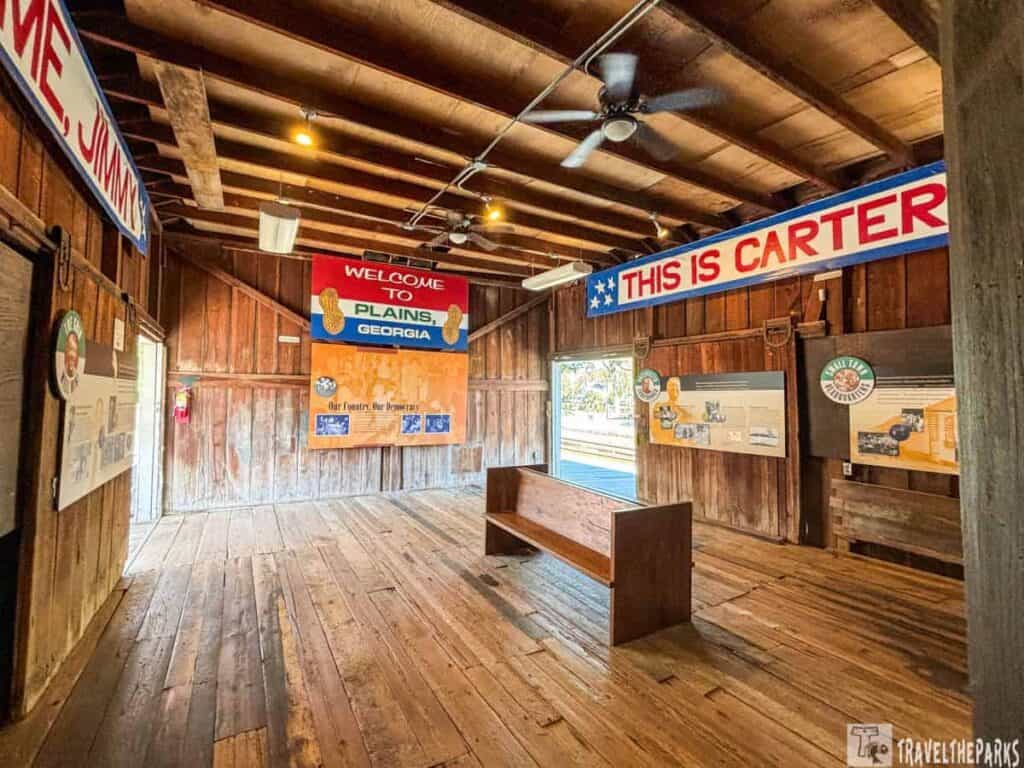
The Exhibits: Grassroots in Motion
What makes The Depot special is that it’s not polished to a presidential shine. This was barebones campaigning—run by volunteers, friends, neighbors. And that authenticity comes through in the displays.
- Victory Night Display–One case shows the celebration photos and headlines from the night he won. The energy leaps off the walls: a man from a town of 600 beating the odds to become President of the United States.
- Telephones & Mail Bins–You’ll see the original phones used by campaign volunteers, who made thousands of calls from this tiny depot to build national support.
- “Peanut Brigade” Stories–There are photos and testimonials from Carter’s supporters—locals who traveled across the country on their own dime to knock on doors and say, “I know this man, and you should too.”
- TV Footage & Audio Clips–Some exhibits feature original campaign ads and snippets from Carter’s speeches. He speaks in a measured, calm, and sincere tone, a stark contrast to today’s political noise. His message? Integrity. Transparency. Change without ego.
- Interesting Fact: The Plains Depot is the oldest building in town, originally constructed by the Savannah, Florida, & Western Railroad. Campaign workers chose it as headquarters because it had a bathroom.
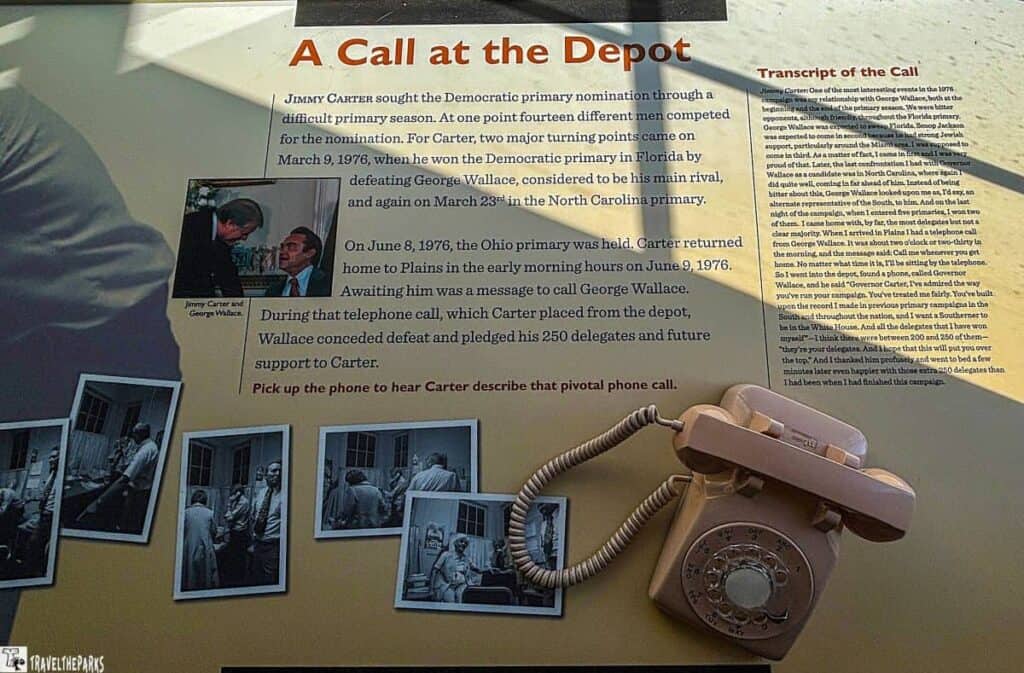
Historic Plains: Small Town, Big Heart
Looping back onto Main Street, we found gift shops with handmade goods, peanut-themed everything, and Carter memorabilia. The Plains Peanut Store is a must—grab some roasted peanuts or peanut brittle and chat with the staff (who are just as much part of the experience as the snacks). Ask for a sample of peanut butter ice cream if it’s available early. It’s legendary.
Pro Tip: Pair your depot visit with a stroll through downtown Plains—it’s just steps away. Grab a peanut butter milkshake at Mom’s Kitchen or Buffalo Café. Shop for political memorabilia at the Plains Trading Post to keep the theme going!
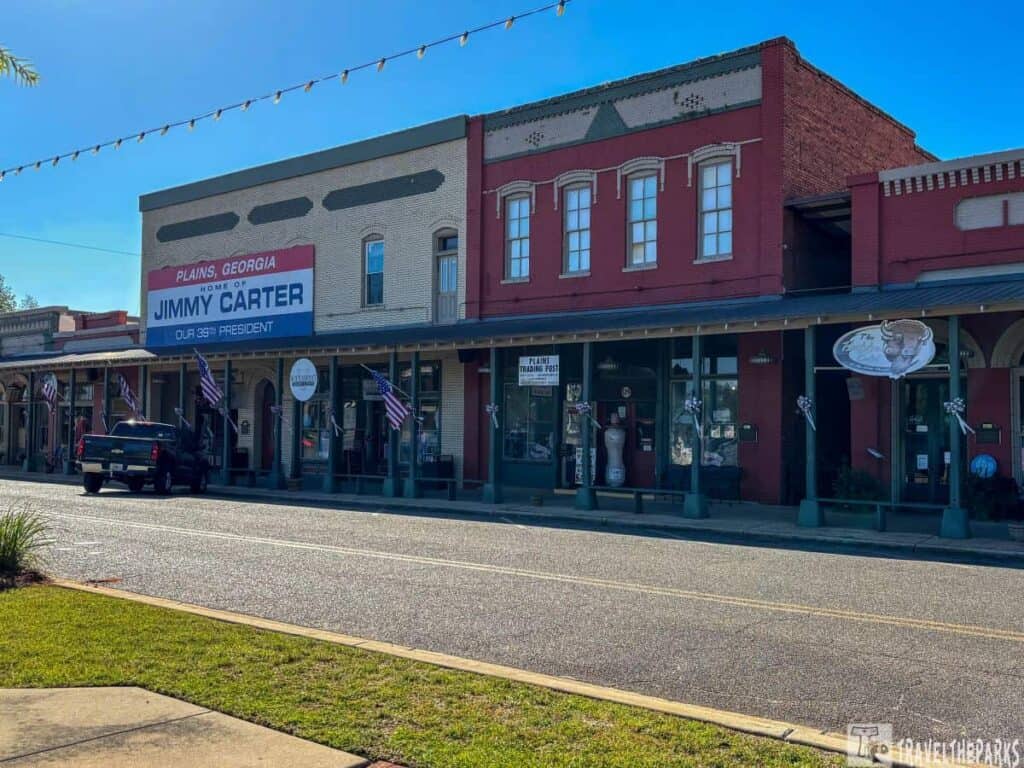
Walking Through the Heart of Jimmy Carter’s Hometown
We started our walking tour with a visit to Plains Baptist Church across from the visitor center. The humble white building where young Jimmy Carter attended services with his family. It’s not open to the public as a museum, but it’s a lovely place to pause, reflect, and appreciate the role that faith and community played in shaping the future president’s life.
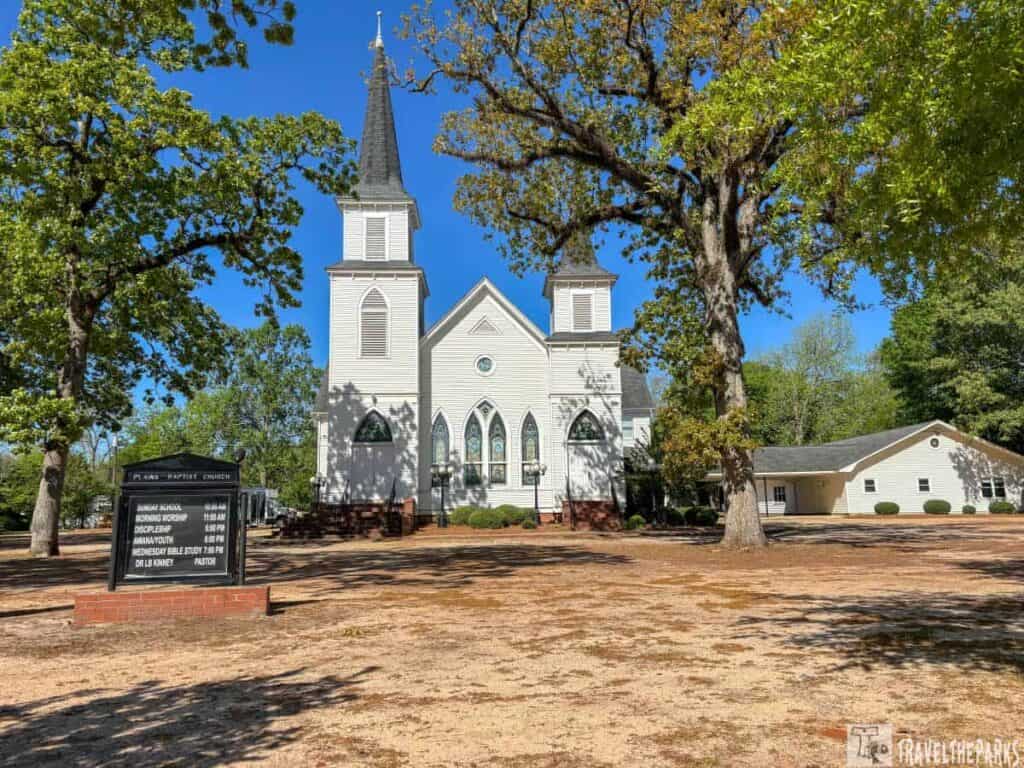
From there, we headed into town for a few classic photo ops. Right in the heart of downtown, you’ll find a variety of peanut cutouts—an ideal stop for a quick snapshot. Just a few steps away is the vibrant “Plains, Georgia” mural, splashed across a downtown wall in bold, cheerful colors. It’s an Instagram favorite, and a great way to capture the small-town spirit with a splash of personality.
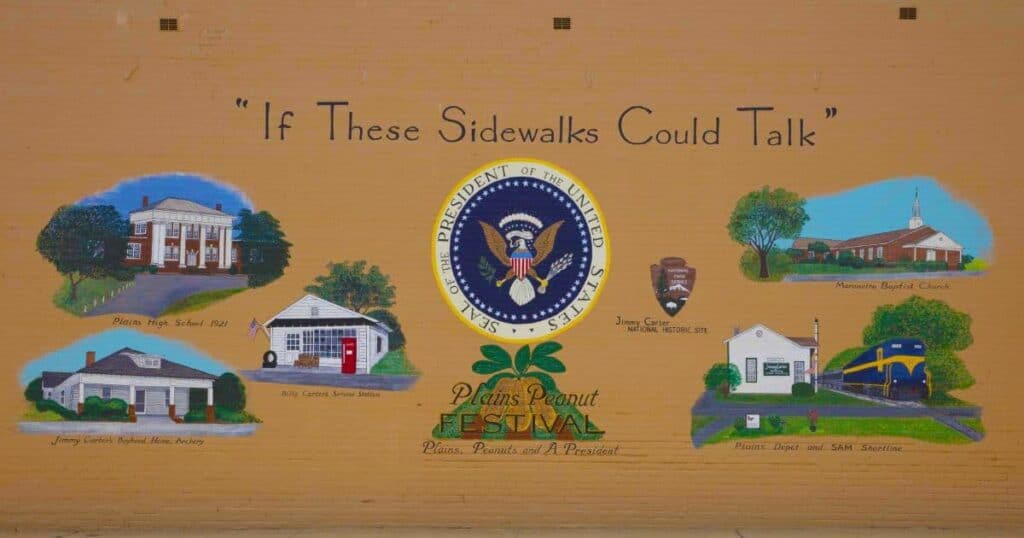
The entire downtown loop is under one mile, making it easy and enjoyable for all ages. The people of Plains are proud of their town’s legacy. They genuinely enjoy sharing stories with visitors. Conversations here feel less like tourism and more like catching up with an old friend.
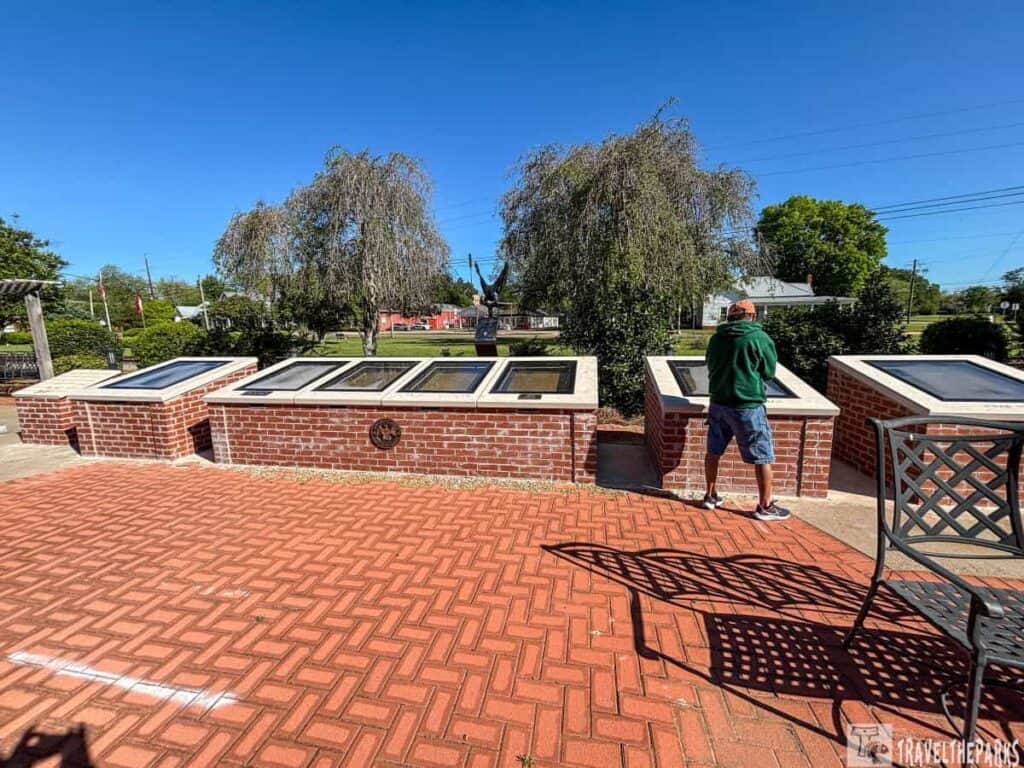
Along your walk, be sure to follow the Rosalynn Carter Trail, where you’ll pass Rosalynn Carter’s childhood home. She lived there until she married Jimmy Carter. Today it’s a private residence.
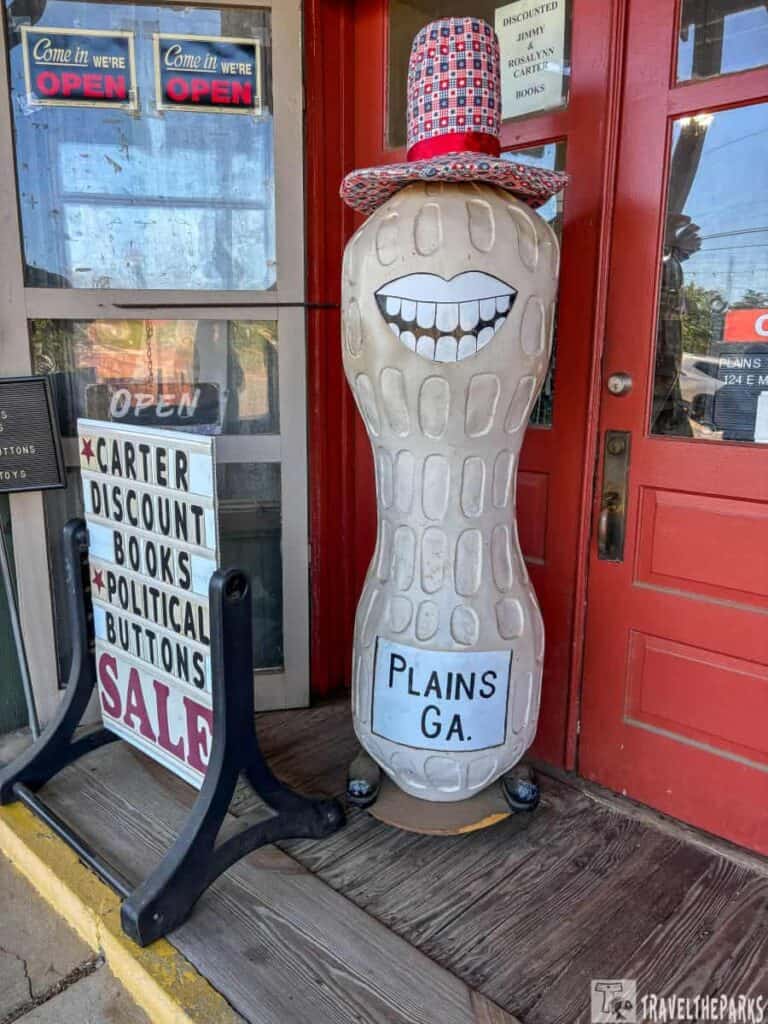
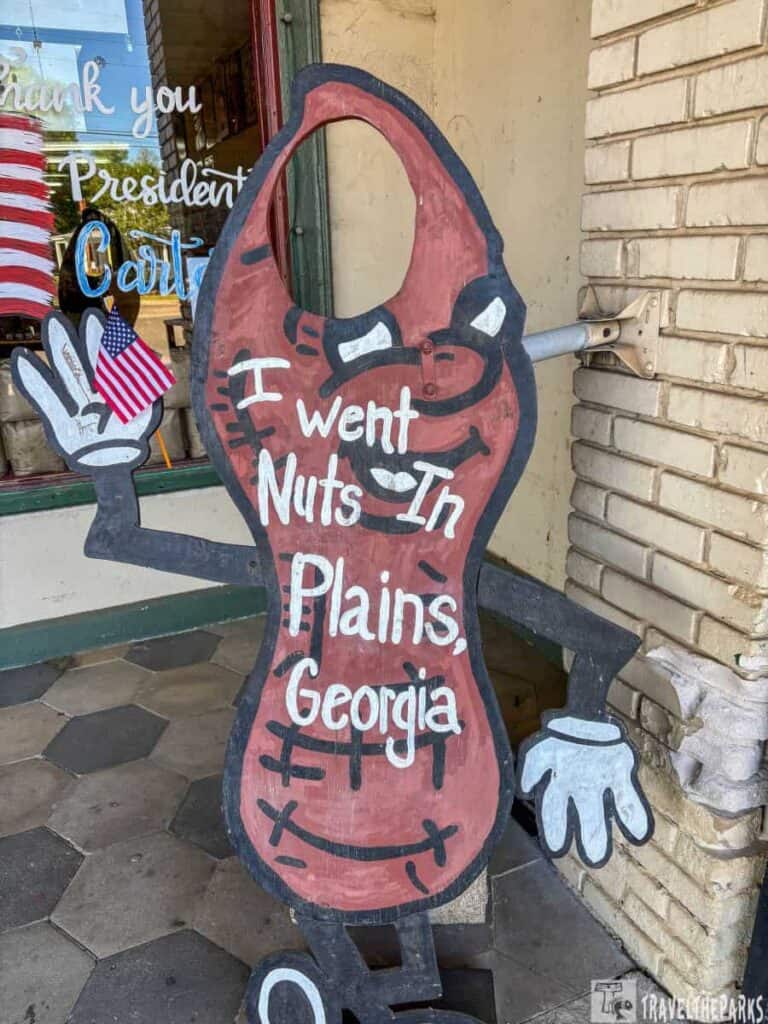
Before the Presidency—There Was the Peanut Warehouse
Before we wrapped up our loop, we again stopped by the Plains Peanut—a cheerful storefront on Main Street that now houses gifts, snacks, and Carter memorabilia. But long before the peanuts and postcards, this building was part of the Carter Warehouse complex, where the Carter family ran their farm supply business. It was here that Jimmy Carter learned the ins and outs of hard work, business, and rural community life—skills that would eventually carry him from peanut farmer to President of the United States.
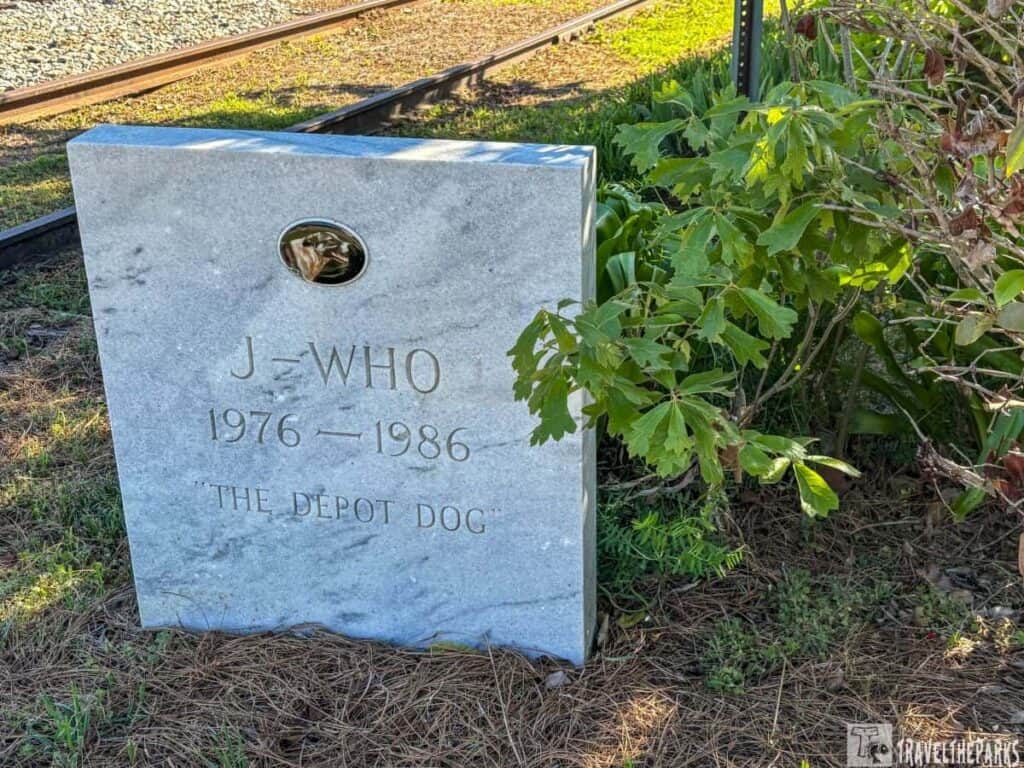
J-Who: The Depot Dog: A Legacy of Kindness
Jimmy Carter might be the most well-known person from Plains, but there’s another local star who is just as loved—J-Who, the friendly Depot Dog who became a beloved part of the community.
Unfortunately, J-Who passed away a few years ago, but people in Plains still remember him well. People in the area talk about him with both warmth and pride. Some stores and social media accounts still share pictures and stories from his time at the Depot.
Although he never held a position in government or wrote a book about his life, J-Who truly represented the spirit of Plains. He was down-to-earth, friendly and had a strong connection to the community.
“He belonged to everyone,” one local said. “Or maybe more truthfully, we all belonged to him.”
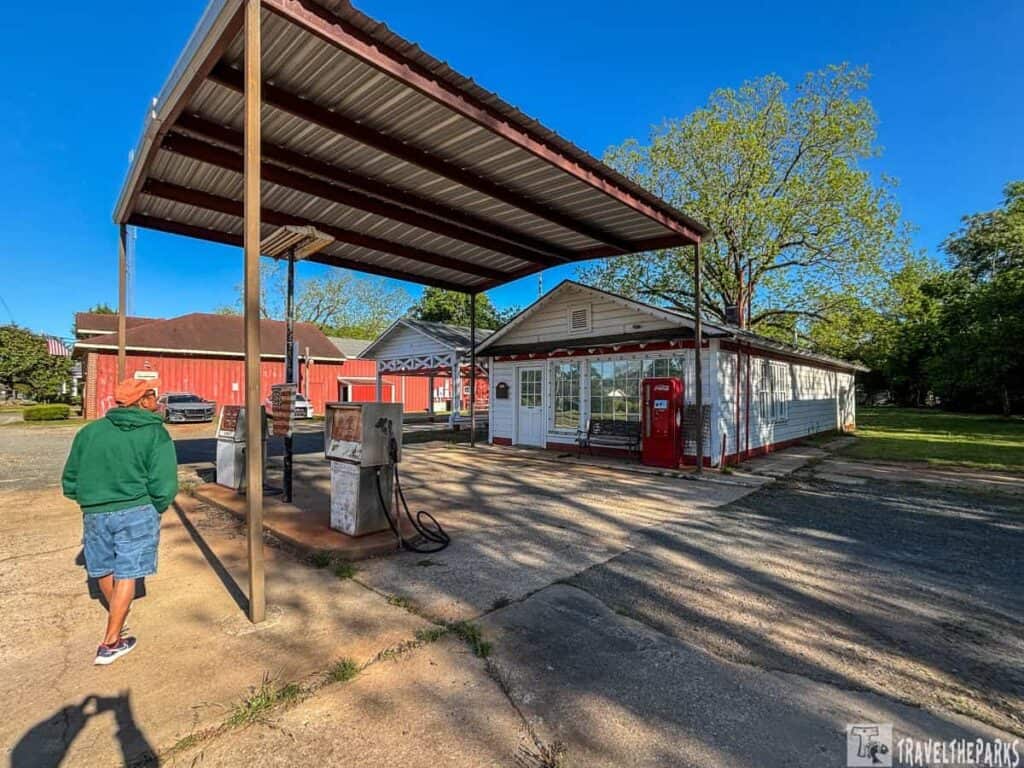
Billy Carter’s Gas Station: Plains’ Most Colorful Landmark
Billy Carter’s Gas Station is a piece of Americana if there ever was one. The original gas pump shows $1.18 a gallon! It’s not just a quirky roadside stop; it’s a window into the personality and colorful side of the Carter legacy, a perfect blend of small-town charm and national curiosity. While Jimmy was known for discipline and diplomacy, Billy became famous for his outlandish personality, frequent beer-in-hand interviews, and his unexpected role in the public eye during the Carter presidency.

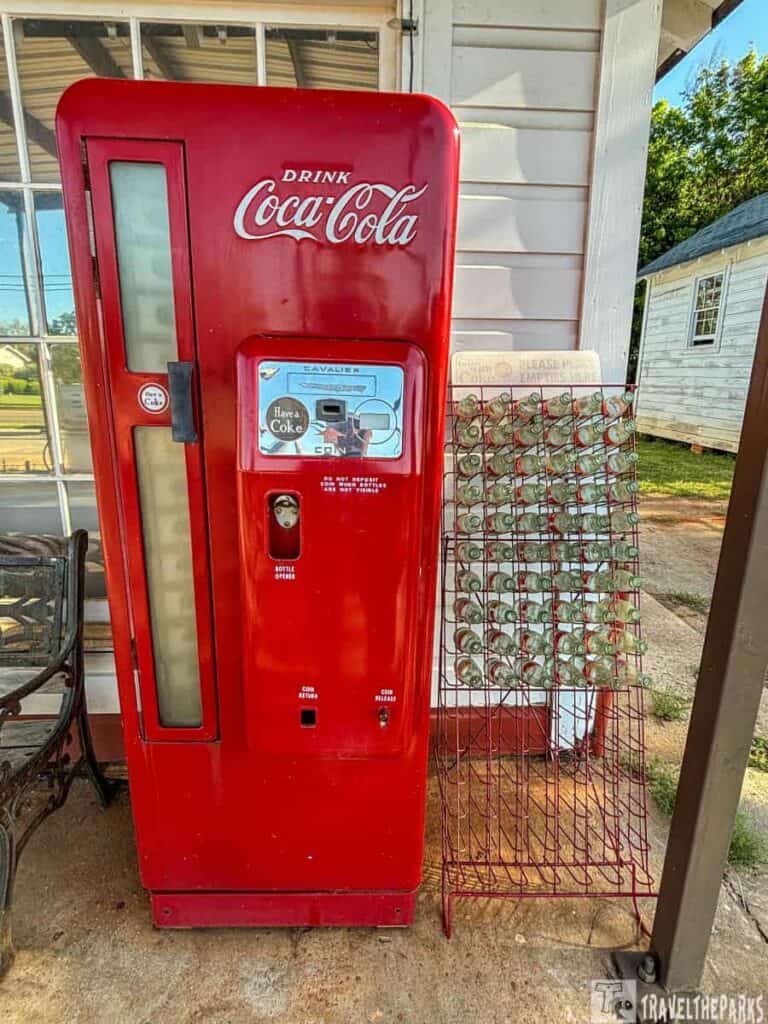
Billy Carter, Jimmy Carter’s brother, ran this gas station from 1972 to 1981. The Jimmy Carter National Historic Site now preserves Billy Carter’s gas station, giving it a small museum-quality feel. It doesn’t take long to walk through, but every corner oozes character. Inside we found:
- Billy Beer memorabilia–Yes, he had his own beer brand.
- Press clippings and magazine covers featuring Billy in his prime. I loved the photo of him with Archie Bunker.
- Personal items like overalls, toolboxes, and hand-scrawled signs.
- Photos of Billy hanging out with journalists, fans, and his more buttoned-up brother.
- A tribute to his humor–You’ll find quotes, jokes, and reflections that show Billy never took himself—or politics—too seriously.
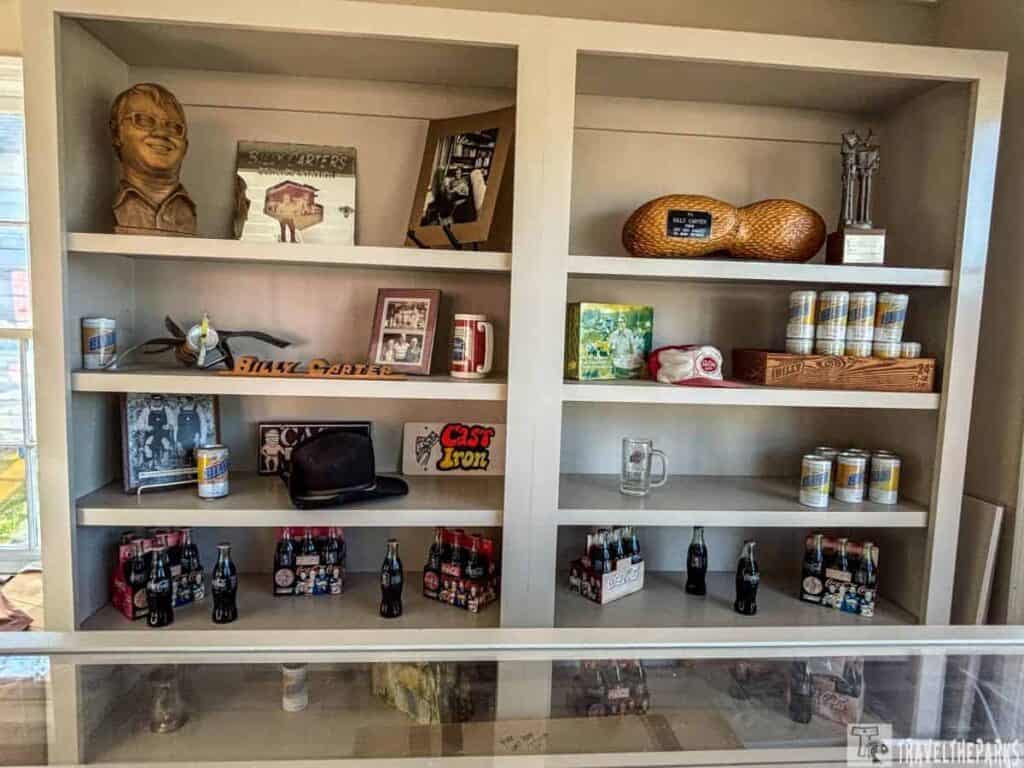
The Carter Family Residence (Exterior Only)
We walked from the school to the edge of town, where the Carter family compound lies. Tucked away behind a modest stretch of trees along Old Plains Highway, the Carter Family Compound—a peaceful, private property that has been home to President Jimmy Carter and First Lady Rosalynn Carter since the 1960s. It’s not open to the public. A simple ranch house sits among the trees next to a small pond, looking as unpretentious as always.
After leaving the White House, Carter returned home, not to rest but to help others. He built houses with Habitat for Humanity, taught Sunday school and worked for peace. His decision to come back to Plains might be the most significant thing he has done: picking being true to himself instead of seeking fame.
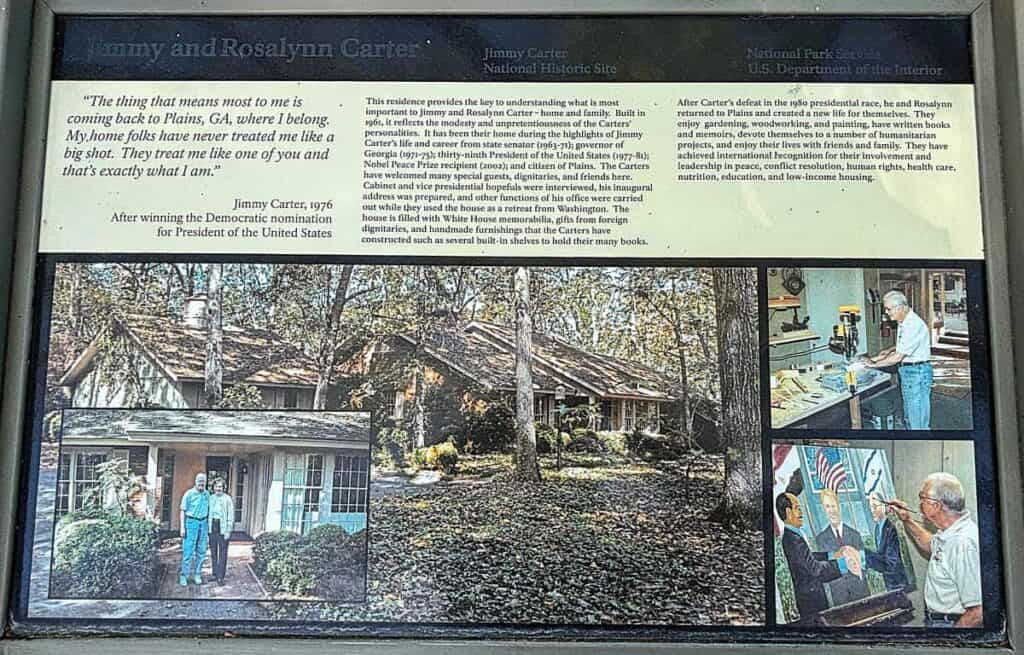
The newly opened gravesite of President Jimmy Carter and First Lady Rosalynn Carter, offers a peaceful place of reflection. Set beside a quiet pond near their longtime home, the simple granite markers reflect their humble lives of service. Visitors can now pay their respects daily at the Carter Memorial Garden. They plan to open the house to the public, possibly in the summer of 2026.
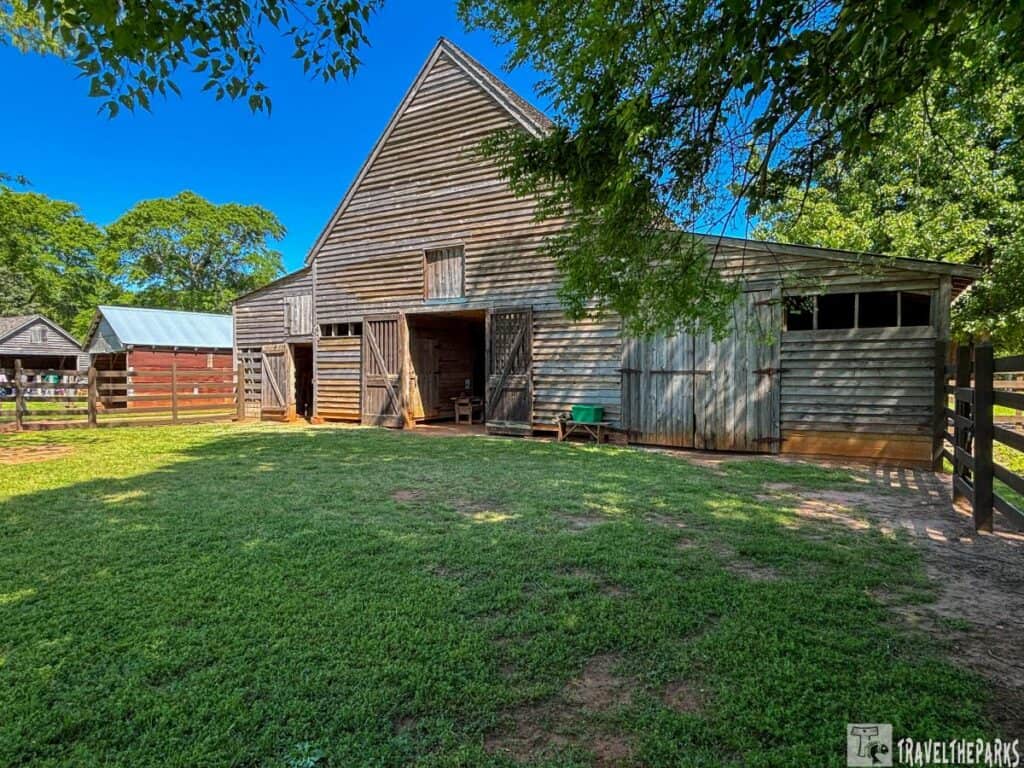
Carter’s Boyhood Farm: A Glimpse into the Roots of a President
Tucked along a quiet rural road just a couple of miles from downtown Plains, the Jimmy Carter Boyhood Farm offers something rare: a chance to walk the same red soil that shaped a young boy into a future president. Here, amid peanut fields, open sky, and the hum of cicadas, Jimmy Carter’s early life comes vividly alive.
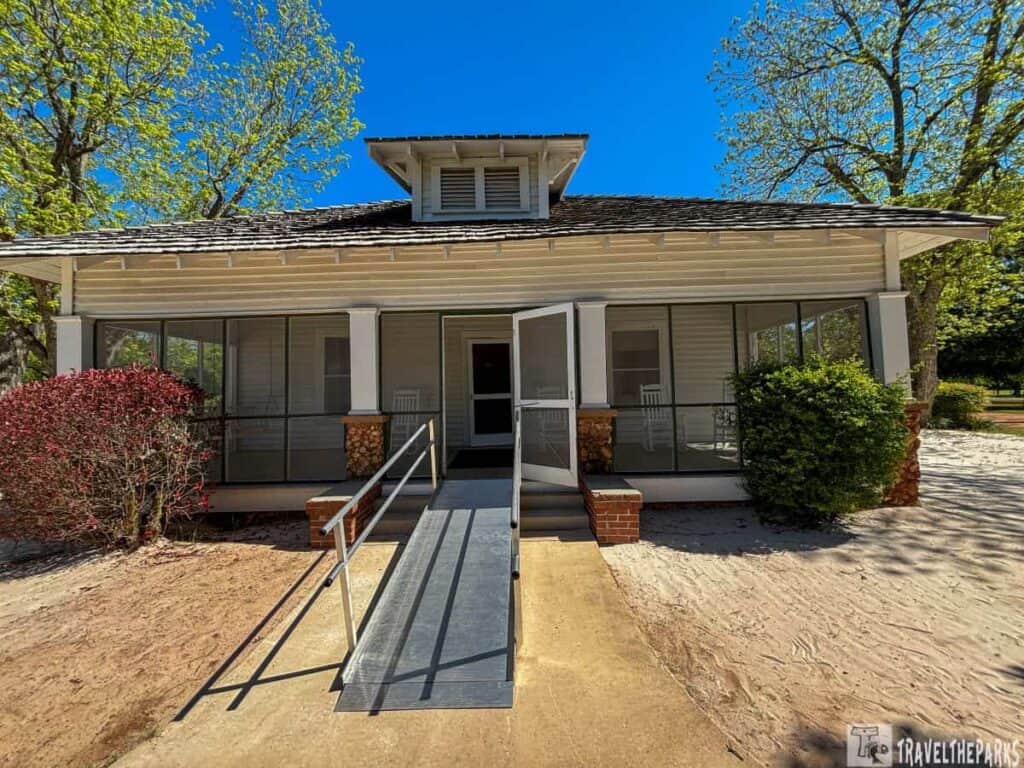
We visited on a sunny morning, and the moment we stepped onto the property, it felt like time had gently rolled backward. Our dog, Sage, was just as taken with the space—tail wagging as we explored the open grounds, with plenty of room to roam along the walking paths. The farm is dog-friendly, as long as pets are leashed and respectful of the animals. Sage especially loved watching the chickens peck near the old barn.
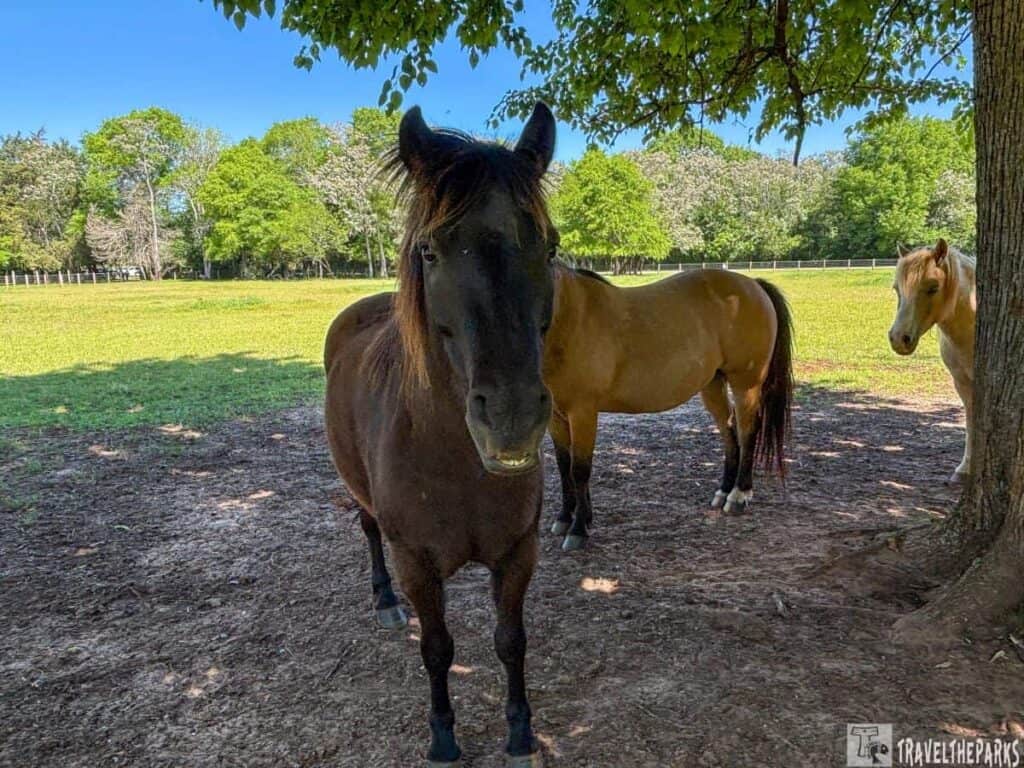
Step Inside the Carter Family Home
Stepping inside the restored 1920s home where Carter lived until age 9, I could easily imagine what life was like in rural Georgia. It’s not a grand estate—it’s a simple, sturdy home, much like the values it helped instill. Inside,we found:
- A wood-burning stove that was once the heart of the home
- Handmade quilts folded neatly across beds
- Oil lamps, worn floorboards, and well-loved furniture that speaks to a time before electricity reached rural Georgia
It’s incredibly easy to imagine young Jimmy doing chores or reading by lantern light, long before presidential motorcades and Nobel Peace Prizes.
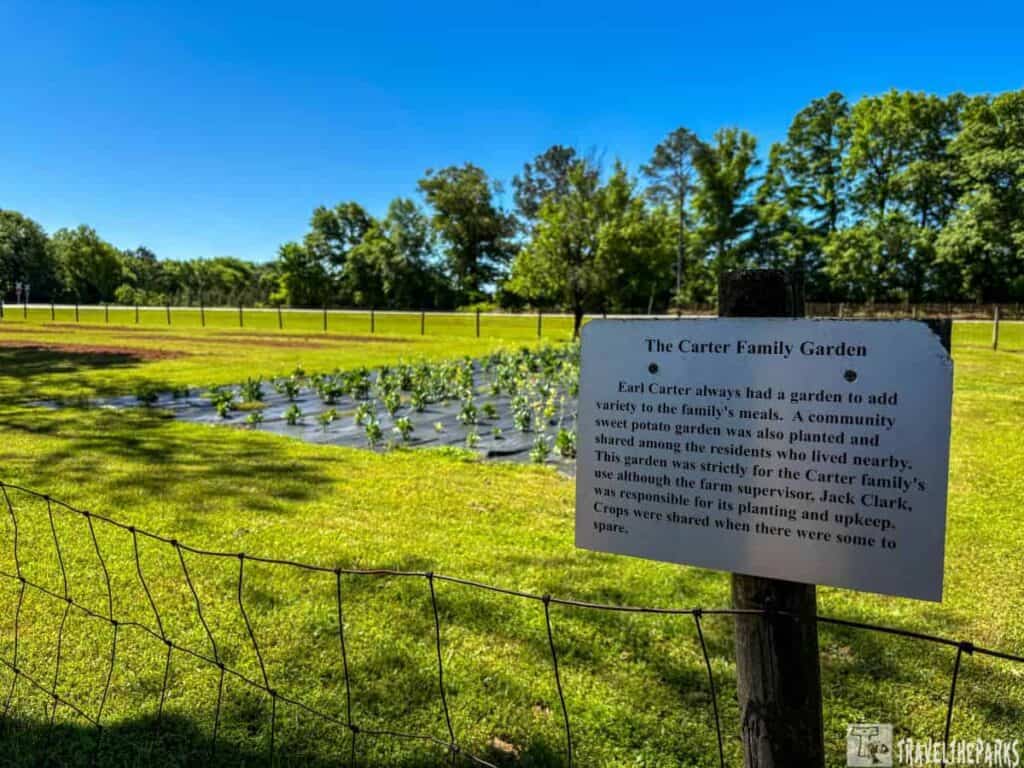
Outside the house, the grounds stretch into a collection of working buildings, including:
- The barn, filled with original peanut-harvesting tools and rustic implements.
- A blacksmith shop, where simple iron tools were shaped by hand.
- Outbuildings for storing crops, firewood, and tools.
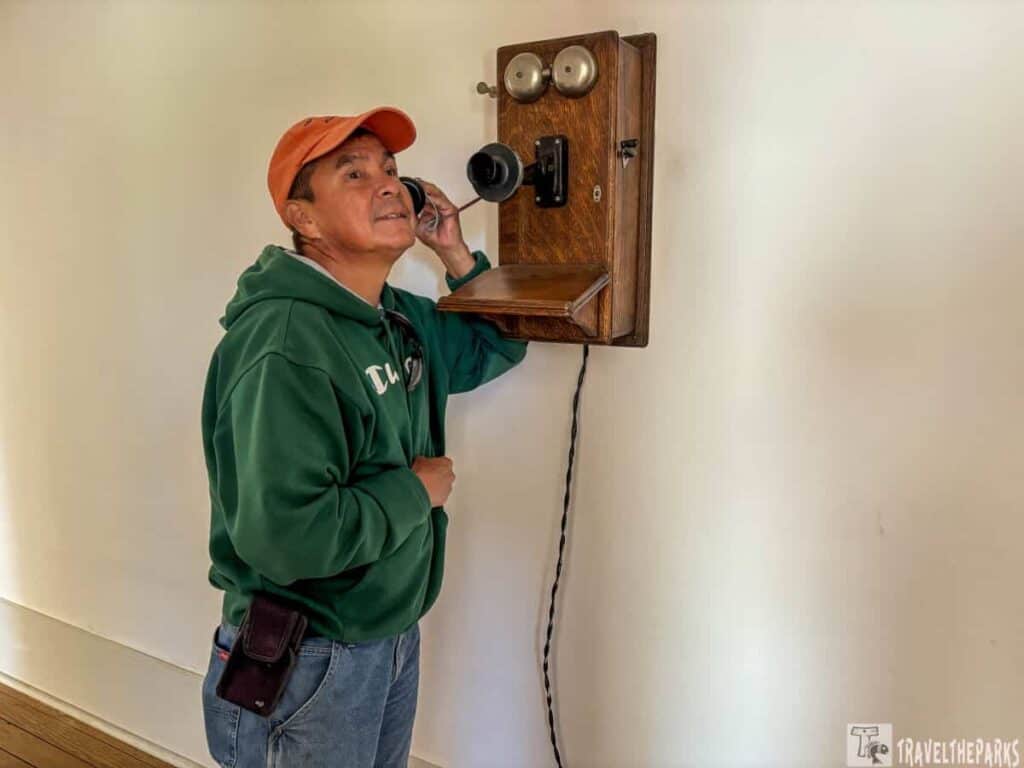
Throughout the day, costumed interpreters in period clothing help bring the farm to life. They share stories, demonstrate traditional tasks, and invite visitors into the daily rhythms of Depression-era farm life.
One of the most moving parts of the visit is seeing Carter’s own words etched into interpretive signs around the property. One in particular stays with you:
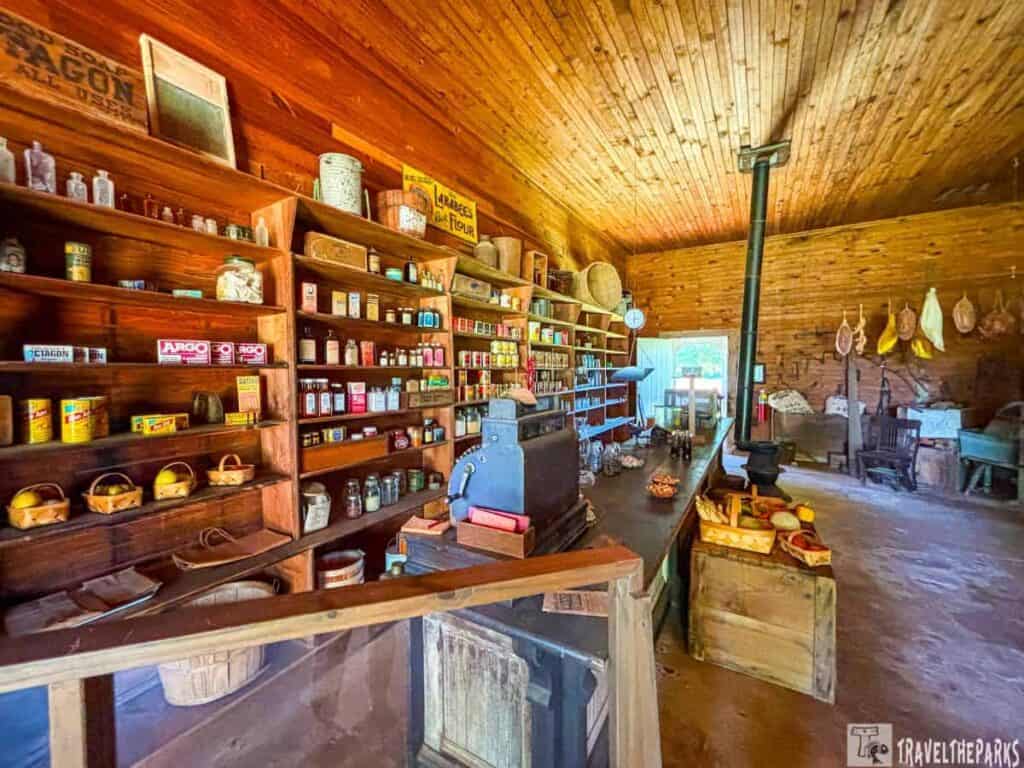
“My most vivid childhood memory is working with my daddy on the farm.”
– Jimmy Carter
This land taught him the value of hard work, fairness, and resilience—qualities that would carry him from peanut fields to the Oval Office.
Pro Tip: Comfortable shoes, sunscreen, water and a hat—shade is limited.
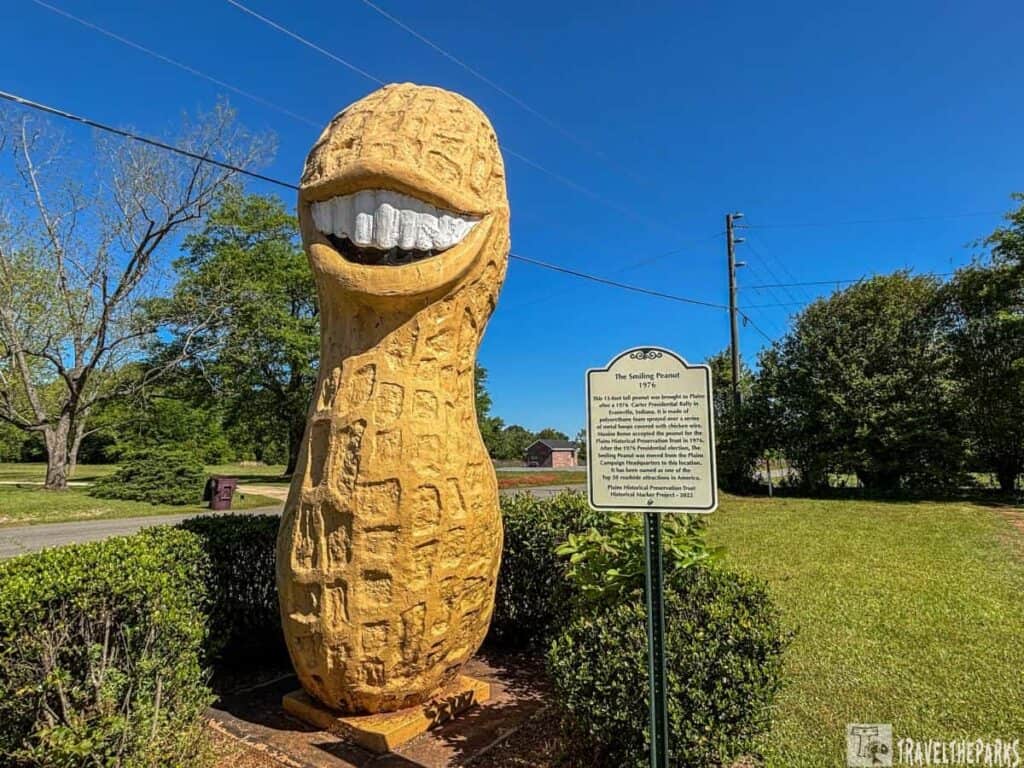
The Smiling Peanut: A Picture-Perfect Welcome to Plains
Last but definitely not least on your Plains adventure is one of the town’s most iconic and quirky landmarks—the Smiling Peanut sculpture.
Standing proudly just off Highway 45 at the edge of town, this oversized roadside attraction features a towering peanut—with none other than President Jimmy Carter’s famous grin painted right across it. It’s cheerful, a little cheeky, and totally unforgettable—just like Plains itself.
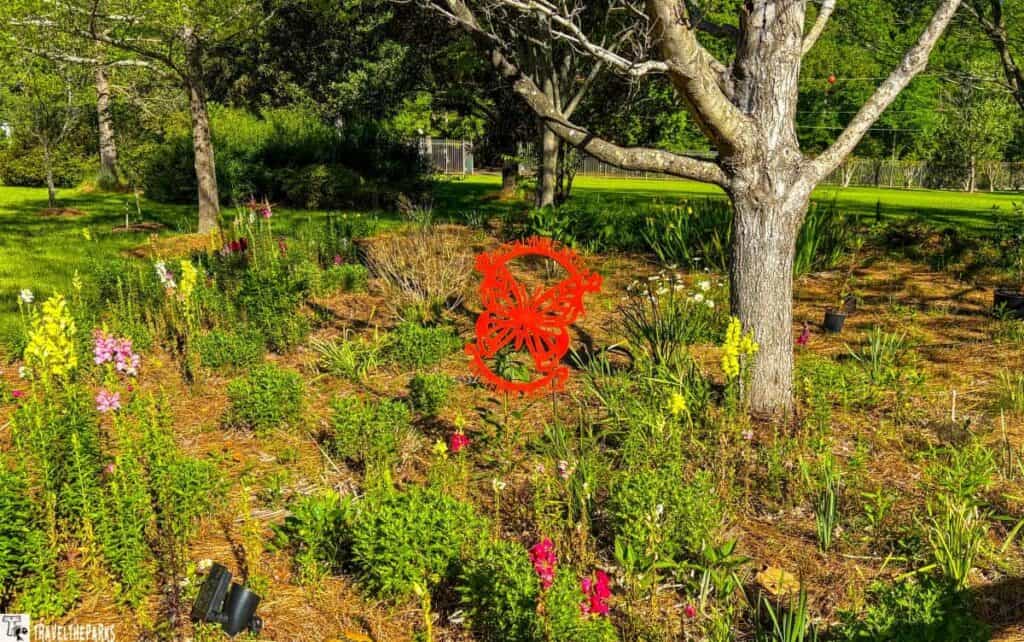
Originally created during Carter’s presidential campaign in the 1970s, the sculpture was meant to be both a nod to his roots as a peanut farmer and a lighthearted piece of campaign fun. Decades later, it’s become a beloved local symbol and one of the most photographed spots in town.
Pro Tip: Time your visit for September’s Plains Peanut Festival—a lively celebration of the crop that shaped the region (and the Carter family’s livelihood!).
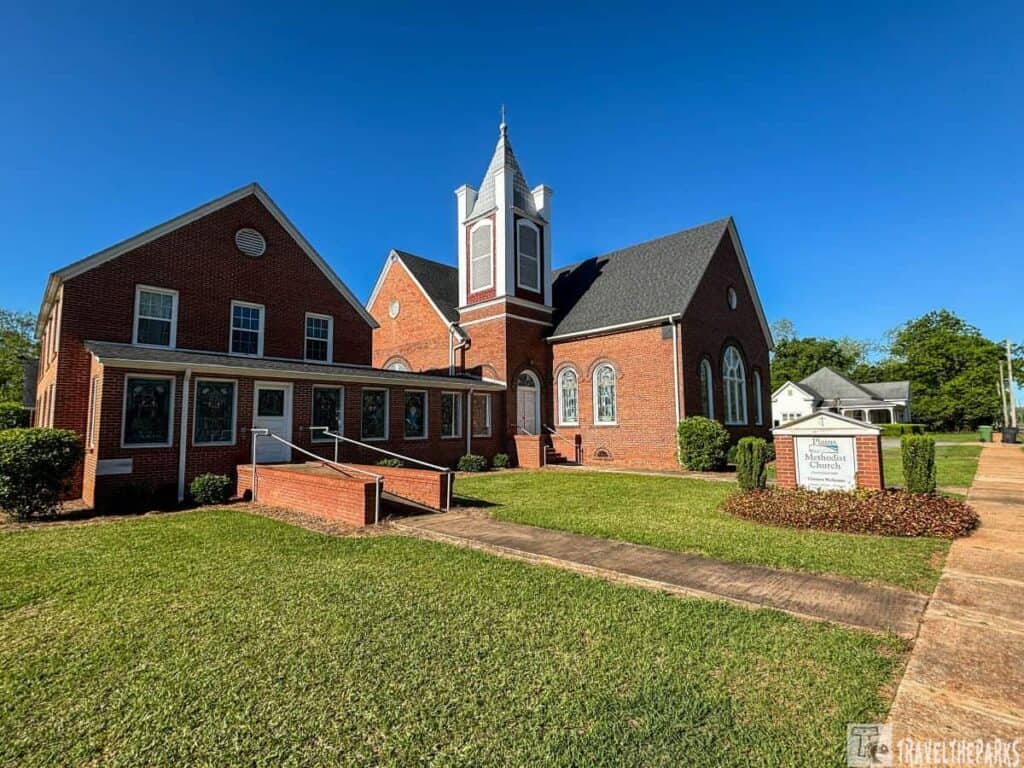
Insider Tips for Your Visit to Jimmy Carter National Historical Park
- Take your time: there is a lot of history to learn at Jimmy Carter National Historical Park, so don’t hurry during your visit. Take in the calm surroundings and think about the important moments in Carter’s life.
- Visit the town visitor’s center: The Plains Depot is full of information and is a perfect place to discover the history of the area.
- Explore the local restaurants: After a day of adventure, enjoy a meal at one of the nearby diners in Plains where you can try some traditional Southern dishes.
- Set aside an entire day: With all the historical sites displays and quiet areas, you’ll want to spend a whole day discovering the park.
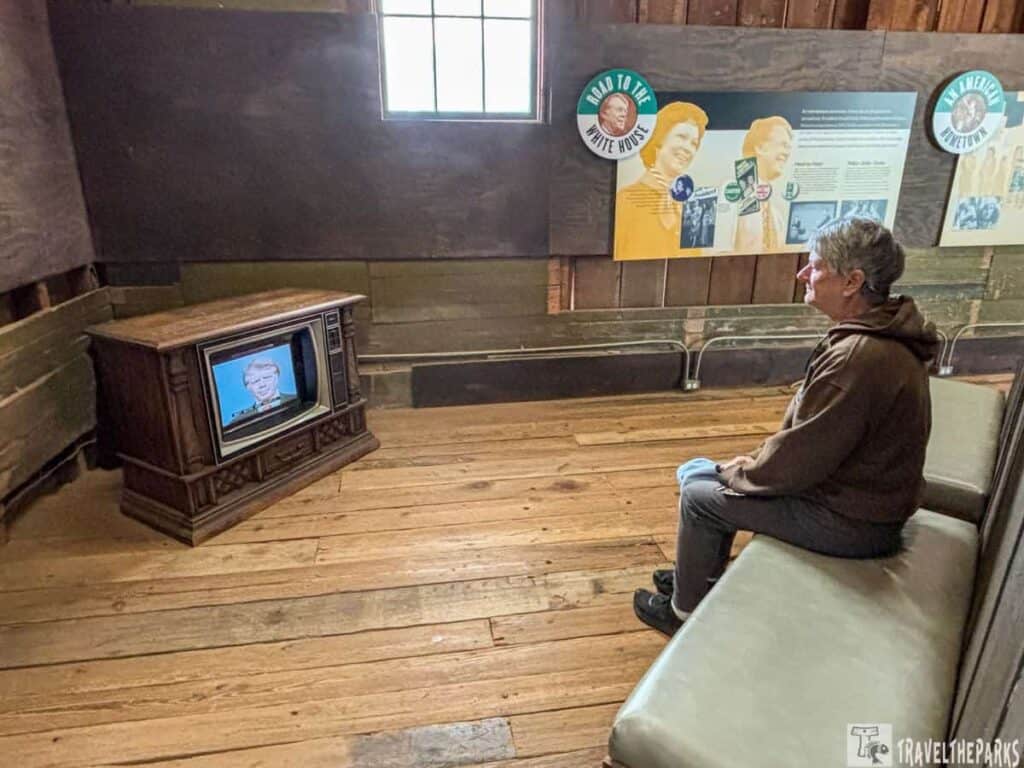
Final Thoughts: A Day at Jimmy Carter National Historical Park: What You Need To Know
Jimmy Carter’s story began not in Washington, but in the quiet town of Plains, Georgia. The Jimmy Carter National Historical Park traces that journey—not one of ego or ambition, but of service, humility, and quiet strength. Walking through his old school, you feel it. You see, the Presidential Medal of Freedom, the Nobel Peace Prize, even the Bible he swore in on—but it’s the small-town backdrop that makes it real.
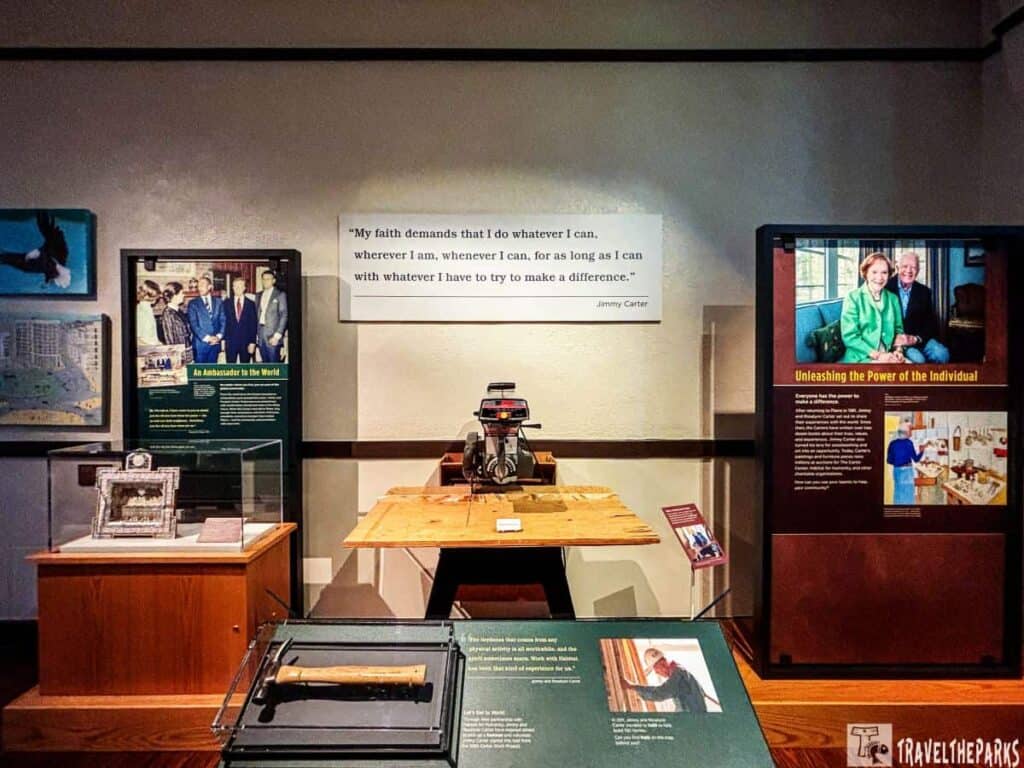
There’s something deeply moving about knowing that the values that shaped a global humanitarian were first learned right here, in a humble classroom in a dusty Southern town.
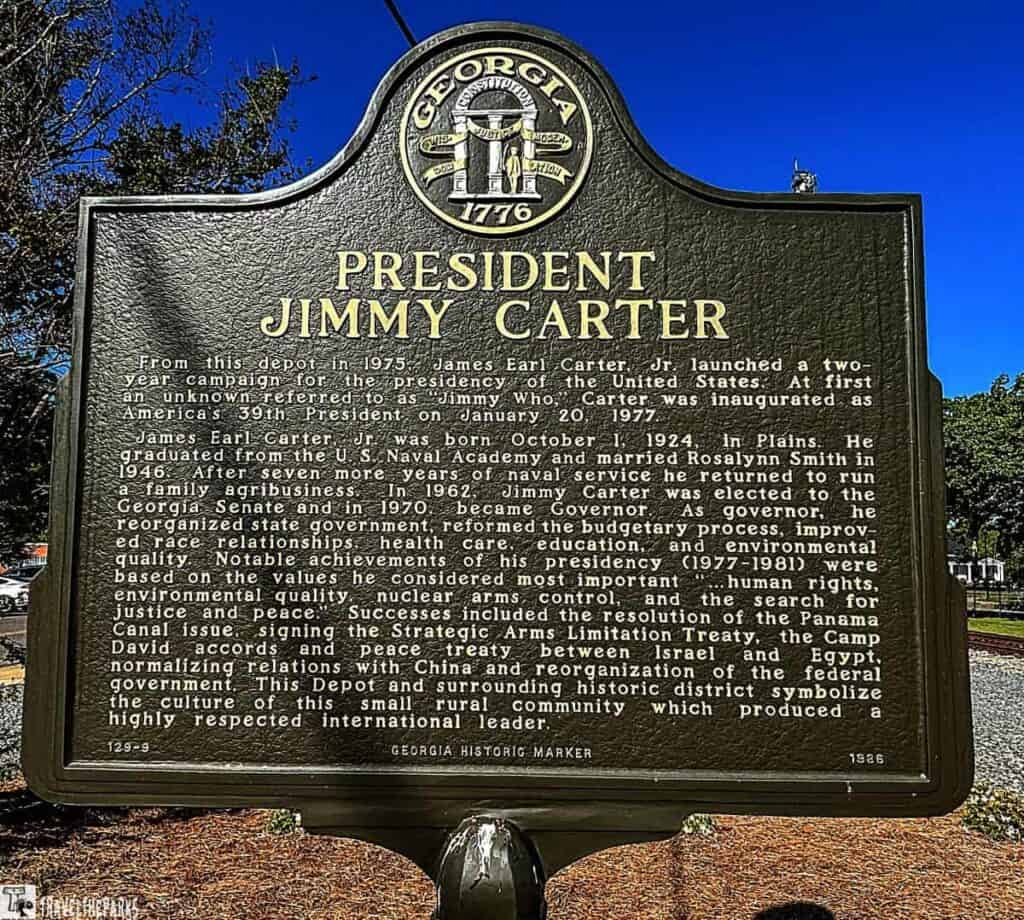
Our Georgia road trip was full of history. We saw Chickamauga and Chattanooga National Military Park first. Then we explored Kennesaw Mountain National Battlefield Park. Ocmulgee Mounds National Historical Park was next on our list. We visited both Fort Frederica and Fort Pulaski. Andersonville National Historic Site stood out. It was a sad reminder of the Civil War prison camp. Finally, we ended our trip, stopping at Jimmy Carter National Historical Park. Breathtaking views and fascinating history made this road trip ideal. It offered something to captivate every type of traveler.
Have you explored Jimmy Carter National Historical Park? What did you like best? Share your thoughts in the comments below.

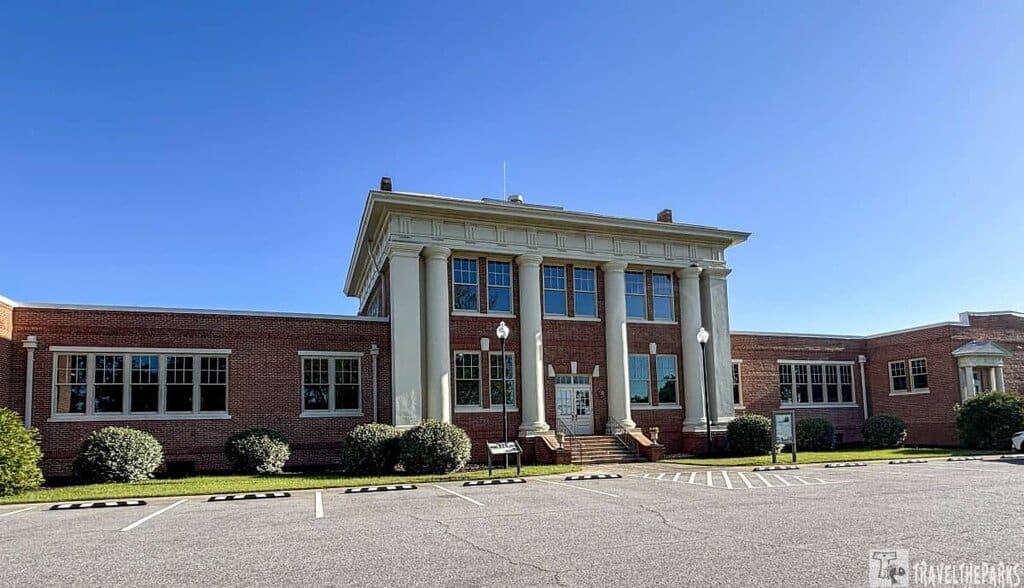
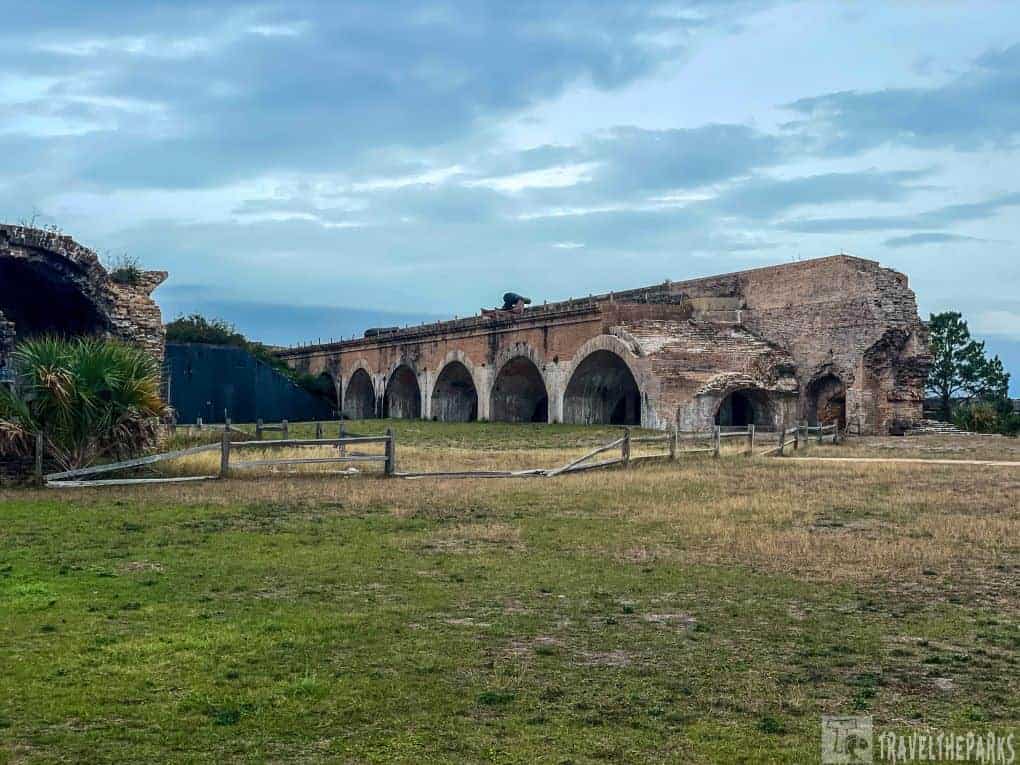

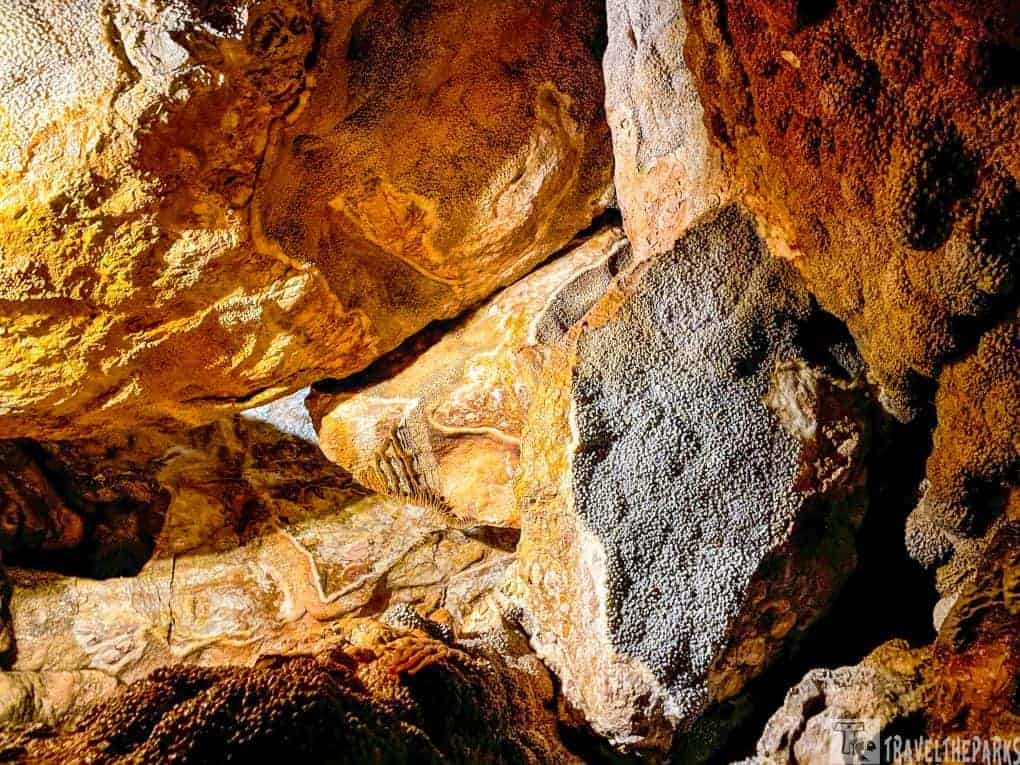
Joan Fonda
A Plains Georgia free travel guide! I do love America history!